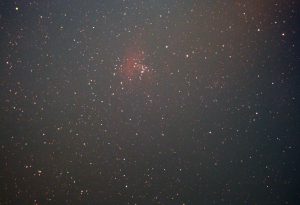望遠鏡を小型なもの(Skywatcher72ED)で頻繁に撮影できるようにし、晴れの日も多くなったので比較的にマシな星雲写真が撮れるようになった。画像処理は未。
およそ5700光年のかなたから来た光。
これから中学時代の望遠鏡や、やや大きめの口径の望遠鏡でも撮影していく。
<Wikiより引用>
わし星雲(わしせいうん、M16、NGC 6611、IC 4703)は、へび座に位置する散開星団と散光星雲の複合した天体である。散開星団の背景に散光星雲が広がっており、メシエ天体としての番号M16は散開星団の方に付けられた番号である。散光星雲にはIC 4703という番号が付けられている。
<From Wikipedia, the free encyclopedia>
This article is about the nebula in the constellation Serpens. For an object in Canis Major, also called Eagle Nebula, see IC 2177. For the astrophotograph, see Pillars of Creation.
Eagle Nebula
Emission nebula
H II region
Three-colour composite mosaic image of the Eagle Nebula, with north at top. Credit: ESO
Observation data: J2000.0 epoch
Right ascension 18h 18m 48s[1]
Declination −13° 49′[1]
Distance 5,700±400 ly (1,740±130[2] pc)
Apparent magnitude (V) 6.4[3]
Apparent dimensions (V) 70 x 50 arcmins[citation needed]
Constellation Serpens
Physical characteristics
Radius 70×55 (cluster 15)[citation needed] ly
Absolute magnitude (V) -8.21[citation needed]
Notable features 1–2 million years old[citation needed]
Designations Messier 16, NGC 6611,[1] Sharpless 49, RCW 165, Cr 375, Gum 83, Star Queen Nebula
See also: Lists of nebulae
The Eagle Nebula (catalogued as Messier 16 or M16, and as NGC 6611, and also known as the Star Queen Nebula) is a young open cluster of stars in the constellation Serpens, discovered by Jean-Philippe de Cheseaux in 1745–46. Both the “Eagle” and the “Star Queen” refer to visual impressions of the dark silhouette near the center of the nebula,[4][5] an area made famous as the “Pillars of Creation” imaged by the Hubble Space Telescope. The nebula contains several active star-forming gas and dust regions, including the aforementioned Pillars of Creation. The Eagle Nebula lies in the Sagittarius Arm of the Milky Way.


